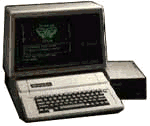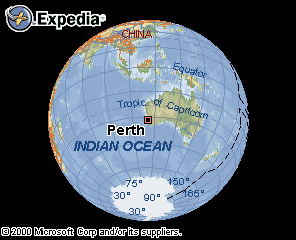Andrew Gregory's Web Pages
Sunset at Walganna Rock, 27°23'54"S 117°28'9"E
 About Me
About MeI have been fascinated by computers ever since I was six and my uncle bought me a children's book about them. Whenever my school's book club listed books even vaguely about computers I bought them. Once, during some school holidays, my parents sent me to a computer course where I did a little programming in Logo (I drew a Rubik's Cube, among other things) on a Microbee computer.
 Then, in 1985 (when I was about thirteen), my Dad bought an early model
Apple 2e! It came with AppleWorks
software (word processor, spreadsheet, database) and three disks of games none
of which, strangely, came with manuals
Then, in 1985 (when I was about thirteen), my Dad bought an early model
Apple 2e! It came with AppleWorks
software (word processor, spreadsheet, database) and three disks of games none
of which, strangely, came with manuals
![]() . Those disks
had a very clever menu program written in Applesoft
BASIC
and my Dad assured me I'd never figure out how it worked. From that I descended
into the world of computer programming and never looked back!
. Those disks
had a very clever menu program written in Applesoft
BASIC
and my Dad assured me I'd never figure out how it worked. From that I descended
into the world of computer programming and never looked back!
(Eventually, I did figure out exactly how that menu program worked, and I even managed to improve it a little. The day I wrote a high-res screen dump to a dot-matrix printer in just two lines of BASIC (with prompts to select which of the two available pages to print, if it should be black-on-white or white-on-black, and left or right justified on the page) I knew I had finally gone a step further than that menu program).
In January 1994 while I was at university I bought a Sharp IQ-8000 organiser. While it can't be considered a "real" handheld computer, I also bought the BASIC programming card (I have some notes on interesting PEEKs, POKEs and CALLs), and that makes it pretty close. I quickly filled its mere 32K with programs, figuring out how to bypass some of its memory limitations.
![]() In 1994, after years of study, I graduated with a Bachelor of Science (Computer
Science) degree from
Curtin University.
In 1994, after years of study, I graduated with a Bachelor of Science (Computer
Science) degree from
Curtin University.
 In December 1994, I was lent a Psion Series 3a to evaluate it for use
communicating with some specialised instrumentation. In that one week I was so
impressed by the programmability (and the multi-tasking) that in March 1995 I
ditched the Sharp and bought the Psion! The program I was evaluating it for
never happened, but I have never regretted buying my 3a. I have since bought a
2MB Flash SSD (upgraded to 4MB
following instructions provided by
Jochen Siegenthaler) and a
1MB RAM
SSD. For those who are interested in
such things, my 3a broke its right hinge - and I didn't drop it or
anything! Months later, the left hinge broke - so I sent it in for
repair and got it back less than a week later (not bad considering it had to get
to Sydney from Perth and back!). They even replaced the name/logo plate on the
front.
In December 1994, I was lent a Psion Series 3a to evaluate it for use
communicating with some specialised instrumentation. In that one week I was so
impressed by the programmability (and the multi-tasking) that in March 1995 I
ditched the Sharp and bought the Psion! The program I was evaluating it for
never happened, but I have never regretted buying my 3a. I have since bought a
2MB Flash SSD (upgraded to 4MB
following instructions provided by
Jochen Siegenthaler) and a
1MB RAM
SSD. For those who are interested in
such things, my 3a broke its right hinge - and I didn't drop it or
anything! Months later, the left hinge broke - so I sent it in for
repair and got it back less than a week later (not bad considering it had to get
to Sydney from Perth and back!). They even replaced the name/logo plate on the
front.
In November 1998 I bought a new 3mx. Much faster than the 3a - the backlight was a bit of a novelty. Power consumption is a bit higher - my 3a averages a little under 30mA, the 3mx is using just on 40mA (as reported by the System).
From 1995 through 1999 I worked as a programmer for Unidata Australia, writing software mainly in C++, but also C, BASIC and some 8051 assembler. I taught myself HTML and CGI scripting with Perl when I developed their web site from scratch. I have since left Unidata Australia to start my own software development business: Southern Cross Software Solutions.
 In January 2000 I bought an
Ericsson MC218
(equivalent to Psion 5mx) and an
Ericsson T18s mobile
phone as a bundle deal. The MC218 came with a DI27 infrared modem that plugs
into the bottom of the T18s. I mainly use it to send and receive
SMS messages, but also download
emails every now and again when I'm 'out and about'. I rarely surf - it's just
too slow!
In January 2000 I bought an
Ericsson MC218
(equivalent to Psion 5mx) and an
Ericsson T18s mobile
phone as a bundle deal. The MC218 came with a DI27 infrared modem that plugs
into the bottom of the T18s. I mainly use it to send and receive
SMS messages, but also download
emails every now and again when I'm 'out and about'. I rarely surf - it's just
too slow!
![]() At the start of 2000 I set up my own business:
Southern Cross Software Solutions.
I'm currently working on three projects. One is developing a Psion-based system
to support datalogger manufactured by my old employer, Unidata Australia. The
other two are Java-based projects. I've had to teach myself Java to do these.
Thankfully, it's very similar to C++ and extremely easy to pick up.
At the start of 2000 I set up my own business:
Southern Cross Software Solutions.
I'm currently working on three projects. One is developing a Psion-based system
to support datalogger manufactured by my old employer, Unidata Australia. The
other two are Java-based projects. I've had to teach myself Java to do these.
Thankfully, it's very similar to C++ and extremely easy to pick up.
In the middle of 2005 I decided my T18s mobile needed retiring. My chosen replacement was a Palm Treo 650 smartphone. My main reason was that I wanted my phone and PDA in one device. With an 8GB SDHC memory card, it's also my navigator (PathAway and converted raster topographic maps) and music machine (almost all my CDs fit!). I'm also experimenting with being able to read my email on the go, via Chatter Email.
At home I own an AMD64 3200+, an Athlon 1GHz, a Celeron 433, a P-200, a 486DX2-66, a 486DX2-50 and an Apple IIe. I used to program in AppleSoft and 6502 machine code. Sadly, all my Apple stuff is lying unused, collecting dust in a corner. Perhaps that's because I wrote my own Apple emulator for the PC?!
The 486DX2-50 (with all of 5MB of RAM - whoo hoo!) is set as solely as a serial port debugging tool. Running MS-DOS 6, it boots into a serial port monitor application that uses two serial ports and a breakout box to monitor data being sent and received. It can be very handy sometimes.
The P-200 is currently dedicated to an electronics project where it runs some server software (on Fedora Core 5 Linux) that communicates to many PIC chips via a CAN bus.
 The Athlon 1GHz is running Linux and acting as my local network file server and
web site test bed. It has a duplicate copy of my 'live' web site where I make
changes to my site before uploading them. It also runs a couple of other sites,
such as my father's. If I produce
a web site for a client I can create a virtual server where they can see their
work in progress.
The Athlon 1GHz is running Linux and acting as my local network file server and
web site test bed. It has a duplicate copy of my 'live' web site where I make
changes to my site before uploading them. It also runs a couple of other sites,
such as my father's. If I produce
a web site for a client I can create a virtual server where they can see their
work in progress.
The AMD64 3200+ is my working computer. Mostly for work, I do play some games in my occasional free time, such as Half-Life 2 and X3:Reunion. I use VMware to run a variety of operating systems, mostly for testing purposes, but also to run a few packages that only run on Windows 98 or Windows 3.1.
All the above are connected to a single keyboard/mouse/screen via a 4-port KVM switch.
The 486DX2-66 used to be my file server, web server and internet connection sharer. It now sits in a corner switched off having been replaced by the Athlon 1GHz mentioned above, and a Dynalink RTA230 I picked up cheap at an auction.
I no longer sync my network time to my GPS. Instead I have long-term plans to build my own microcontroller-based time server that could connect the GPS directly on to my network.
The Celeron 433 is also doing nothing right now.
I live in Perth, Western Australia.

(Maps from Expedia.com)
![]() Forecasts,
Observations, and
Weather Radar
from the
Bureau of Meteorology for Perth, Western
Australia. On the Observations page, average Ocean Reef and Swanbourne for my
current weather!
Forecasts,
Observations, and
Weather Radar
from the
Bureau of Meteorology for Perth, Western
Australia. On the Observations page, average Ocean Reef and Swanbourne for my
current weather!